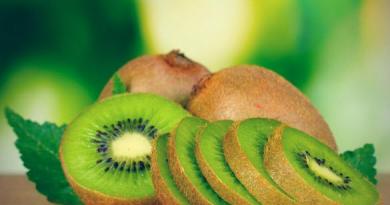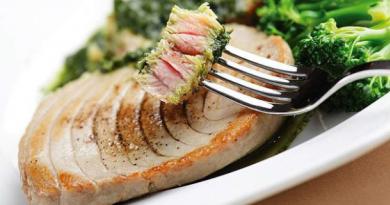Now the opinion is spreading that animal fats are absolutely harmful, they must be abandoned and only vegetable fats should be eaten. Opponents of such a position prove the groundlessness of these statements. Let's try to figure out what quality Peasant or Vologda butter should be in order to meet the requirements of GOST.
What is Butter
The product is made from the milk of large and small cattle. In Russia, it is produced by the method of separation or churning of natural pasteurized cow's fresh cream. Due to the high fat content, the product is not consumed on its own. It is used for making sandwiches, added to cereals, in mashed potatoes, in dough, it improves the taste of food. From raw materials - heavy cream - the product is distinguished by a high fat content: from 50 to 99%.
Compound
In addition to fat, the dairy product consists of milk proteins, carbohydrates, and water. Butter contains cholesterol, lecithin, saturated and unsaturated fatty acids:
- oleic;
- palmitic;
- myristic;
- linoleic;
- lauric;
- oil;
- nylon;
- capric;
- caprylic.
The product contains vitamins: A (retinol), C (ascorbic acid), E (tocopherol), PP (niacin), group B (thiamine, riboflavin, folic acid), carotene, calciferols, and minerals:
- selenium;
- magnesium;
- potassium;
- calcium;
- iron;
- sodium;
- phosphorus;
- manganese;
- zinc;
- copper.
GOST
Requirements for the manufacture of the product are contained in GOST 32261-2013. Such figures, and not others, should be indicated in the labeling on the packaging of a quality product. The standard allows the content of preservatives, food coloring carotene, acidity regulators. The inclusion of vegetable fats in the product: palm, coconut and other GOST is prohibited. For production as raw materials, the manufacturer can use:
- cow's milk;
- cream;
- buttermilk;
- table salt.
calories
The dairy product is high-energy due to the high fat content - from 50 to 99 percent. Due to the low melting point - 32 degrees - fat is easily absorbed by the body. The calorie content of 100 grams of the product is:
- 552 kcal - for 60% fat;
- 610 kcal - for 67%;
- 626 kcal - for 72.5%;
- 748 kcal - for 82.8%;
- 892 kcal - for 99%.
Kinds
According to the standard, the product must be made from pasteurized cream with or without sourdough, so there are types:
- sweet creamy;
- sour cream.
Within these groups, the production of cow fat can be carried out with or without the addition of salt, so there are types:
- salty;
- unsalted.
The product is distinguished by fat content, the consumer is offered the following fat content of butter:
- Tea - 50% mass fraction;
- Sandwich - 61%;
- Peasant - 72.5%;
- Amateur - 80%;
- Vologda - 82.5%;
- Traditional - 82.5%.
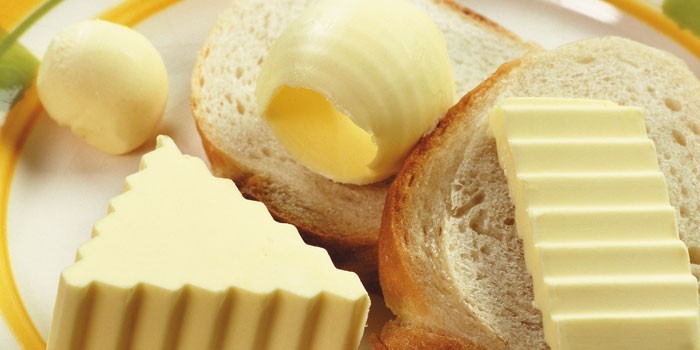
The best varieties
The requirements for Tea and Sandwich oils are not provided for by the terms of the standard; due to their low fat content, they cannot be considered a product of high quality animal origin. They may include harmful vegetable and hydrogenated impurities. Melted cow fat is obtained after evaporation of moisture by thermal processing, so it contains almost no useful bioactive substances and trace elements, but has harmful carcinogenic free radicals.
Peasant oil has good qualities with a fat content of 72.5%. It is characterized by a special sour-cream flavor, because it is made according to a technology different from other types - from unpasteurized cream. With a fat content of 80-82.5% (Amateur, Traditional brands), the manufacturer does not need to use emulsifiers to achieve a uniform consistency.
It is necessary to highlight the Vologda oil. It is produced according to a special recipe, according to special specifications by three manufacturers: the plant named after. Vereshchagin, ZAO Vologda Dairy Plant, OAO Sheksninsky Dairy Plant. Produced from the milk of grass-fed cows, it is characterized by a special sweet creamy smell with a nutty flavor. Among domestic brands, the quality rating of butter can be arranged in the following sequence:
- Vologda with a fat content of 82.5%;
- Traditional and Amateur fat content 80-82.5%;
- Peasant.
Useful properties of butter
Cow solid fat is indispensable for the human body due to its chemical composition:
- Selenium has anticarcinogenic properties.
- Cholesterol does not contribute to the appearance of atherosclerosis and heart disease due to the presence of oleic acid and lecithin, which regulate lipid metabolism and prevent the accumulation of plaques.
- Oleic acid has anti-cancer properties.
- Cholesterol promotes the production of bile acids necessary for the digestion process, the dairy product is included in the diet for cholecystitis.
- Vitamin A inhibits the secretion of gastric juice, this component is recommended by medicine in the diet for the healing of stomach and intestinal ulcers.
- Vitamins A and E are good for vision.
- Vitamin C helps boost immunity.
- Lauric acid has antimicrobial and antifungal properties, so the dairy product is recommended to be used for medicinal purposes for colds and tuberculosis.
For the female body
The benefits of butter for a woman's body are provided by the content of the following substances:
- cholesterol. The presence of this component helps to maintain the balance of female hormones at the required level, and the lack of it leads to the disappearance of menstruation and infertility.
- Folic acid, lecithin. Contribute to the improvement of the condition of the skin, hair, nails.
- lipids. The fats accumulated in the cells help protect the skin from wind and frost, and ensure skin health.
- calcium. Actual for pregnant women and during lactation.
For men
The food product is necessary for the rapid replenishment of energy. Animal fat can be easily absorbed by the body and help restore strength after strenuous exercise. It is a valuable source of cholesterol, which men need to produce healthy spermatozoa. A lack of a substance can lead to a decrease or loss of reproductive function..
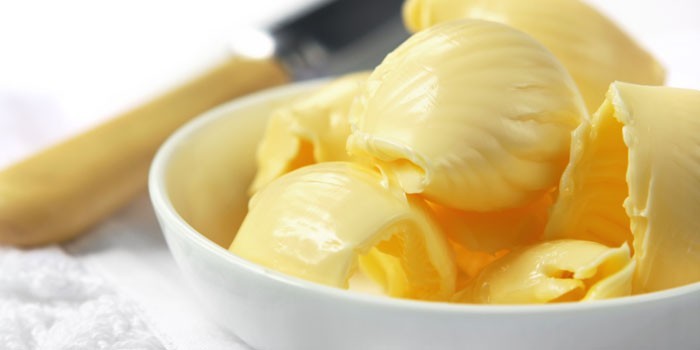
For kids
Replenishment of calcium by the body is important in childhood. The product has a valuable property - the fat-soluble tocopherols contained in it ensure the complete absorption of this element from milk fat. Cholesterol plays a special role in the development of the child: it is necessary for the renewal of nerve tissues and the normal functioning of the child's brain. Exclusion from the diet of cow fat entails a lack of nutrients, cholesterol, which can cause:
- decreased concentration;
- poor assimilation of the material;
- mental decline.
How much butter can you eat per day
Since the product contains a large percentage of fat and has a high calorie content, it is necessary to observe the norms of its consumption. Children are recommended to eat no more than 7 grams daily. Adult consumption can be increased to 30 grams. You should not give up cow fat in diseases of the liver and pancreas, but only reduce consumption to 20 grams.
Harm of butter
Currently, the benefits and harms of butter are a topic that is the subject of discussion. With proper nutrition, moderate use of fatty varieties of the product, cow fat cannot be harmful. The following must be taken into account:
- You can not use the product for frying and baking and use ghee, because during heat treatment carcinogens are formed.
- Cow fat contains a small amount of protein, so allergic reactions are possible. Such cases are less common than with the use of milk.
- Excessive use of cow fat can lead to overweight, obesity.
How to choose butter
Which butter is better to buy so as not to harm your health? The first information can be obtained from the packaging:
- The presence of vegetable fats in the composition of the animal product is harmful to the human body.
- A large implementation term - over 30 days - indicates the presence of a preservative.
- For the consumer, the best packaging is a metallized film - it prevents the destruction of vitamins.
Signs of good butter
Checking butter for quality is carried out in accordance with GOST. The standard forbids the implementation of the product:
- with extraneous taste and smell (rancid, greasy, musty, moldy, chemicals);
- heterogeneous, crumbling, sticky, loose consistency;
- non-uniform color.
To be released to the consumer, the product must meet the requirements for organoleptic characteristics (taste, smell, texture, color) and labeling. There is a rating scale according to which each of the indicators is given a score. After summing them up, the grade of oil is determined:
- the highest grade - 17-20 points;
- first grade - 11-16 points.
If the score is below 11 points, the goods are not allowed to be sold. When buying a dairy product, remember the following:
- You need to try its consistency - if the product is pressed through when you click on the package - you can’t buy it, because. this is the result of the addition of vegetable fats.
- After the refrigerator, high-quality cow fat should be solid, cut into a piece and not crumble.
- It is not a piece of cow fat that has a natural creamy smell, but a product that melts in your mouth.
- The color should not be bright yellow - this is a sign of the presence of a dye.
- A long shelf life indicates the use of preservatives by the manufacturer.
- A quality product should melt in your mouth, not stick to your teeth, and evenly dissolve in warm water.
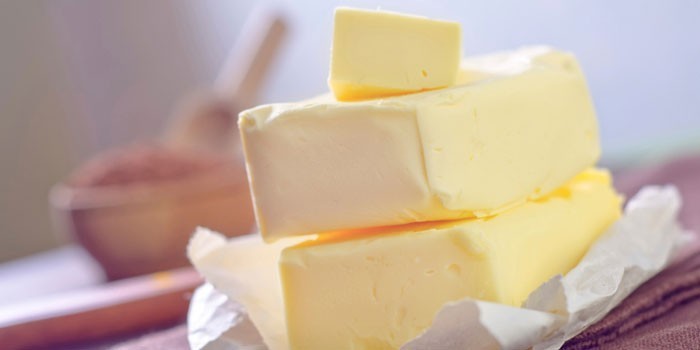
Poor quality oil
To produce a kilogram of product, 20 to 30 kilograms of milk is needed, so the low price of the product indicates the presence of ingredients that are not of animal origin. You can identify a defective product by:
- the presence of a pronounced odor - it is possessed by counterfeit products containing flavorings;
- bright yellow;
- soft, friable, non-uniform interspersed with consistency (indicates the presence of milk fat substitutes);
- fission into particles in warm water rather than dissolution.


